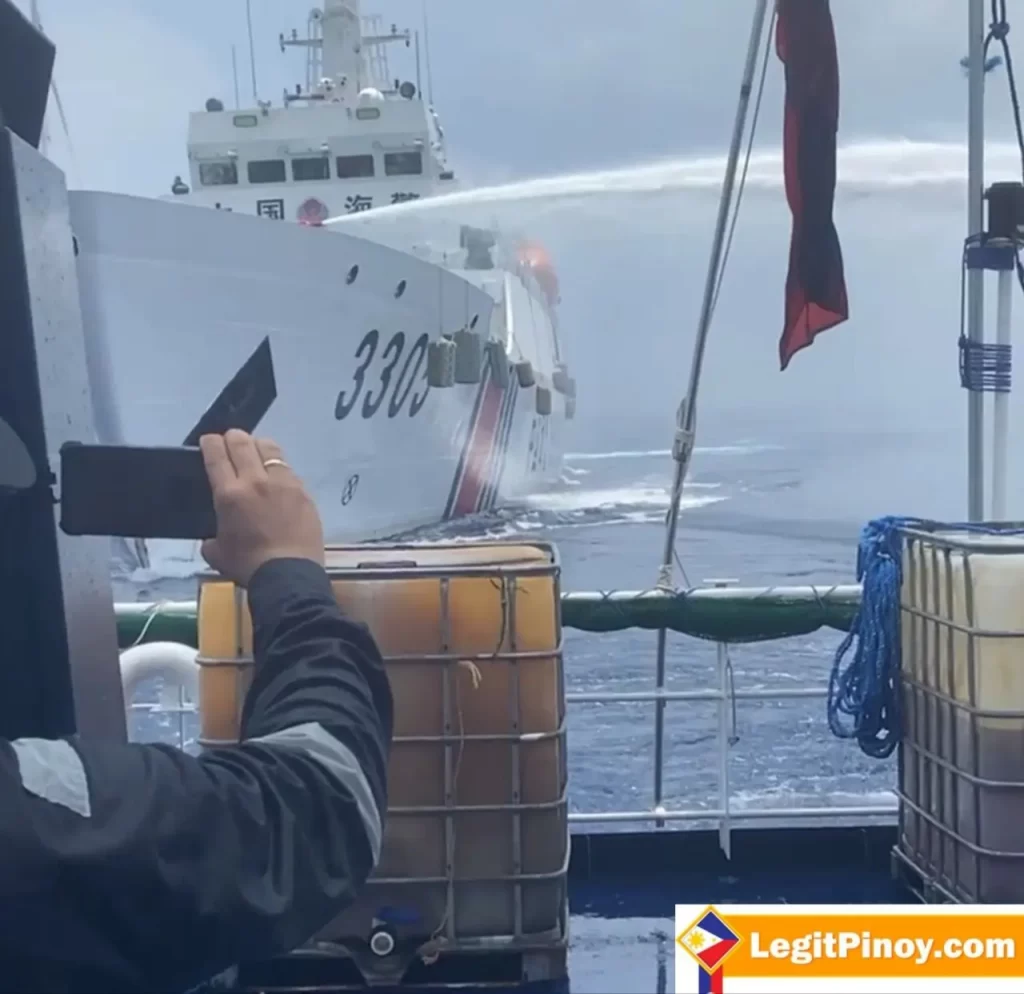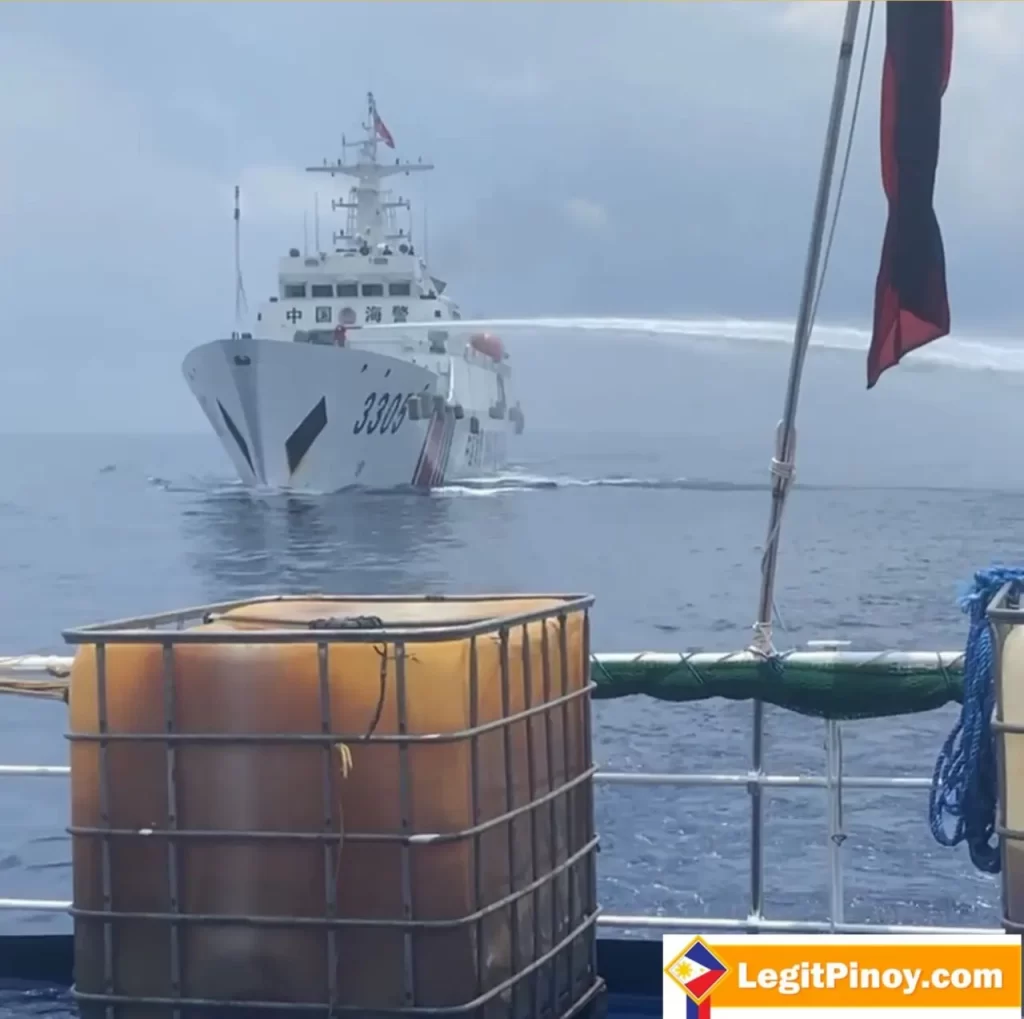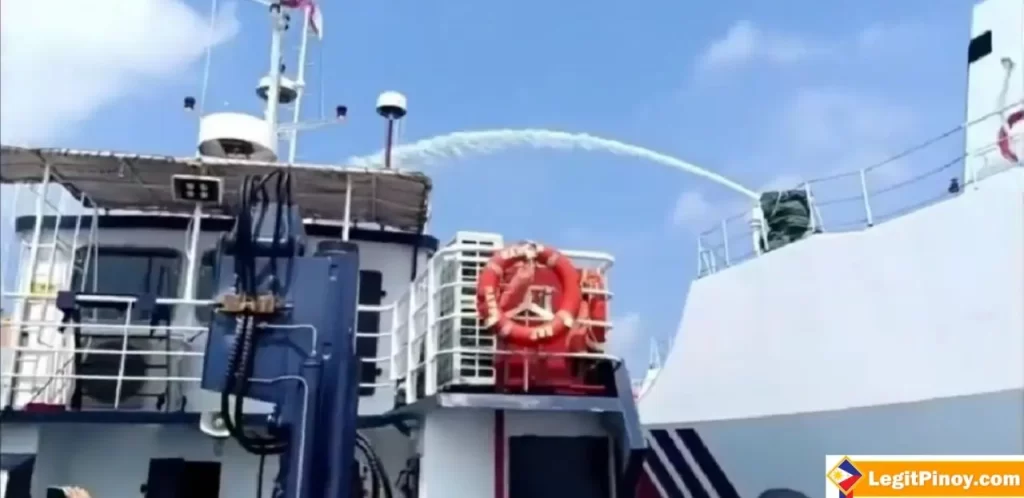West Philippine Sea: “China Coast Guard vs. Philippine Vessels”
During the resupply mission at Bajo de Masinloc, the China Coast Guard fired water cannons at two Philippine vessels, PCG Ship and BFAR, on Tuesday (April 30, 2024).

Advertisement

Introduction
The West Philippine Sea, a significant body of the South China Sea, has long been a focal point of geopolitical tension and maritime disputes. This naval area, encompassing various islands, reefs, and shoals, holds immense strategic and economic value and is a vital conduit for international trade and commerce. However, complex and contentious territorial claims lie beneath its azure waters, fueling longstanding conflicts among neighboring countries.
At the heart of the West Philippine Sea dispute lies a clash of territorial sovereignty, resource exploitation, and maritime rights. Multiple nations, including China, the Philippines, Vietnam, Malaysia, and Taiwan, assert overlapping claims to the region, each citing historical, geographical, and legal arguments to support their respective positions. These claims often intersect with the provisions of the United Nations Convention on the Law of the Sea (UNCLOS), which delineates the rights and responsibilities of coastal states regarding maritime zones and boundaries.
The West Philippine Sea dispute has been marked by a series of confrontations, incidents, and diplomatic maneuvers, reflecting the complex dynamics at play in the region. China’s expansive territorial claims, characterized by the construction of artificial islands and military installations, have drawn international condemnation and raised concerns about the militarization of the area. On the other hand, the Philippines has sought to uphold its sovereign rights and maritime entitlements while pursuing diplomatic avenues for resolving disputes peacefully.
Against this backdrop of competing interests and geopolitical rivalries, the West Philippine Sea dispute remains a pressing challenge to regional stability and international order. This dispute’s outcome carries significant implications for the claimant states, the broader Asia-Pacific region, and the global maritime community. As tensions continue to simmer and maritime activities intensify, finding a mutually acceptable and durable solution to the West Philippine Sea dispute remains a paramount concern for all stakeholders.
Overview
In a recent escalation of tensions in the West Philippine Sea, the international community was alarmed by reports of the China Coast Guard firing water cannons at Philippine vessels during a resupply mission at Bajo de Masinloc. The incident, which occurred on Tuesday, April 30, 2024, underscored the volatile nature of maritime disputes in the region and raised concerns about the safety and security of vessels navigating these contested waters.
According to accounts from Philippine authorities, the incident took place as Philippine Coast Guard (PCG) Ship and a Bureau of Fisheries and Aquatic Resources (BFAR) vessel were engaged in a routine resupply mission at Bajo de Masinloc, a shoal located within the Philippines’ exclusive economic zone (EEZ). As the boats were carrying out their operations, they were intercepted by the China Coast Guard, which deployed water cannons against them.
The use of water cannons by the China Coast Guard damaged the Philippine vessels and posed a significant risk to the safety of their crew members. Images and videos circulated online depicted the tense standoff between the two sides, highlighting the gravity of the situation and the need for immediate de-escalation measures.
The incident drew swift condemnation from the Philippine government, which lodged diplomatic protests against China and demanded accountability for the provocative actions of its Coast Guard personnel. Philippine officials reiterated the country’s commitment to upholding its sovereign rights and maritime entitlements in accordance with international law, including the United Nations Convention on the Law of the Sea (UNCLOS).
Internationally, the incident sparked renewed calls for peaceful resolution of maritime disputes in the West Philippine Sea and underscored the importance of upholding freedom of navigation and respecting the rights of all coastal states. The United States and other like-minded countries expressed solidarity with the Philippines and called for restraint and dialogue to prevent further escalation of regional tensions.
As tensions simmer in the wake of this incident, the international community remains vigilant and continues to monitor developments in the West Philippine Sea. Efforts to find a diplomatic solution to the underlying disputes in the region are ongoing. Still, the recent escalation is a stark reminder of the challenges and complexities of navigating these contested waters.
Statement of Purpose
This analysis explores the multifaceted implications of the recent incident involving the China Coast Guard firing water cannons at Philippine vessels in the West Philippine Sea. Specifically, this examination aims to shed light on how this provocative act impacts Philippine sovereignty and contributes to the broader dynamics of regional stability in the Asia-Pacific region.
This study seeks to elucidate the erosion of the Philippines’ territorial integrity and maritime rights due to China’s aggressive actions by dissecting the incident’s ramifications through the lens of Philippine sovereignty. Furthermore, it explores this incident’s legal, political, and strategic dimensions, assessing its implications for the Philippines’ pursuit of its sovereign rights and maritime entitlements under international law, particularly the United Nations Convention on the Law of the Sea (UNCLOS).
Moreover, this analysis aims to contextualize the incident within the Asia-Pacific region’s broader regional stability and security framework. By examining how this incident contributes to escalating tensions and militarizing maritime disputes, this study seeks to elucidate the potential risks posed to regional stability and the implications for the broader geopolitical landscape.
Ultimately, this examination aspires to provide policymakers, scholars, and stakeholders with a comprehensive understanding of the recent incident’s implications for Philippine sovereignty and regional stability. By uncovering the underlying dynamics and assessing the long-term implications, this analysis aims to inform strategies for conflict resolution, promote dialogue and cooperation among stakeholders, and contribute to efforts to preserve peace and stability in the Asia-Pacific region.
Background Information:
Historical Context of the West Philippine Sea Dispute
The West Philippine Sea dispute is rooted in a complex history of competing territorial claims, colonial legacies, and geopolitical rivalries that have shaped the maritime landscape of the Asia-Pacific region for centuries.
- Colonial Era:
- The dispute’s origins can be traced back to the colonial era when European powers, including Spain and later the United States, asserted control over the Philippines and other territories.
- Spain’s colonization of the Philippines in the 16th century laid the foundation for the country’s territorial claims in the South China Sea, including the Spratly Islands, Scarborough Shoal, and other features within the West Philippine Sea.
- The Treaty of Paris in 1898, which ended the Spanish-American War, transferred sovereignty over the Philippines from Spain to the United States, further entrenching Western influence.
- World War II and Postwar Developments:
- The outbreak of World War II and the Japanese occupation of the Philippines disrupted the status quo in the region but did not resolve the territorial disputes.
- Following the war, the United States granted independence to the Philippines in 1946 but retained military bases and influence in the region.
- The postwar period saw renewed assertiveness from neighboring countries, particularly China and Vietnam, which claimed various islands, reefs, and shoals in the South China Sea, including those within the West Philippine Sea.
- Cold War Dynamics:
- The onset of the Cold War brought new dimensions to the territorial disputes in the South China Sea, as competing ideologies and alliances fueled regional tensions.
- The strategic importance of the South China Sea as a vital maritime route and potential source of natural resources heightened the stakes for claimant states, leading to increased militarization and assertiveness.
- Modern Era:
- The end of the Cold War and the emergence of China as a global economic and military power brought renewed attention to the South China Sea disputes.
- China’s expansive territorial claims, manifested through the construction of artificial islands and military installations, have challenged the status quo and raised concerns among neighboring countries, including the Philippines.
- The Philippines’ efforts to uphold its sovereign rights and maritime entitlements in accordance with international law, particularly the United Nations Convention on the Law of the Sea (UNCLOS), have led to diplomatic tensions and occasional confrontations with China and other claimant states.

- Territorial Claims of China and the Philippines:
The territorial dispute in the West Philippine Sea revolves around competing claims over islands, reefs, and maritime features by China, the Philippines, and other neighboring countries. China asserts historical claims to almost the entirety of the South China Sea, restricted by the controversial Nine-Dash Line, which encompasses significant portions of the West Philippine Sea. These claims are based on historical records, including ancient maps and nautical charts, dating back to the Ming and Qing dynasties. However, these claims have been disputed by the Philippines, which asserts its sovereignty over features within its exclusive economic zone (EEZ) and extended continental shelf in accordance with international law.
- Establishment of the United Nations Convention on the Law of the Sea (UNCLOS) and its Relevance to the Dispute:
The United Nations Convention on the Law of the Sea (UNCLOS), adopted in 1982 and entered into force in 1994, provides the legal framework for governing maritime affairs and delineating naval zones and boundaries. UNCLOS establishes the rights and responsibilities of coastal states, including determining territorial seas, EEZs, and continental shelves. The Philippines, China, and other neighboring countries are a signatory to UNCLOS. UNCLOS is highly relevant to the West Philippine Sea dispute as it forms the basis for the Philippines’ claims to maritime entitlements and serves as a legal framework for resolving conflicts among coastal states. The Philippines has pursued its claims within the framework of UNCLOS, particularly by submitting its extended continental shelf claim to the Commission on the Limits of the Continental Shelf (CLCS). However, China’s refusal to recognize the arbitral tribunal’s ruling on the South China Sea arbitration case initiated by the Philippines in 2013 underscores the challenges of implementing UNCLOS in the context of the West Philippine Sea dispute.
Evolution of tensions in the West Philippine Sea
The West Philippine Sea has been a hotbed of tensions and conflicts, evolving due to historical grievances, geopolitical rivalries, and resource competition. Understanding the evolution of these tensions provides a crucial context for comprehending the current state of affairs in the region.
- Historical Background:
- Tensions in the West Philippine Sea can be traced back to centuries-old territorial disputes and colonial legacies.
- Various historical claims by China, the Philippines, Vietnam, Malaysia, and Taiwan over islands, reefs, and shoals in the South China Sea have laid the foundation for contemporary conflicts.
- Strategic Importance:
- The West Philippine Sea holds immense strategic significance because it is a vital maritime corridor and gateway to significant shipping routes.
- The region is rich in natural resources, including oil and natural gas reserves, fisheries, and minerals, making it a focal point for resource exploitation and competition among claimant states.
- Militarization and Reclamation:
- In recent decades, tensions in the West Philippine Sea have escalated due to the militarization and reclamation activities undertaken by various claimant states.
- China’s construction of artificial islands, military installations, and airstrips in disputed waters has raised concerns about its regional intentions and capabilities.
- Incidents and Confrontations:
- The West Philippine Sea has witnessed numerous incidents and confrontations between rival claimant states, including China and the Philippines.
- These incidents range from military standoffs and naval encounters to harassment of fishermen and interference with maritime activities.
- Legal Challenges and Arbitration:
- Legal challenges and arbitration proceedings have further heightened tensions in the West Philippine Sea.
- The Philippines’ decision to initiate arbitration proceedings against China in 2013, resulting in the landmark ruling by the Permanent Court of Arbitration in 2016, underscored the legal dimensions of the disputes.
- Diplomatic Maneuvering:
- Diplomatic efforts to address tensions in the West Philippine Sea have been ongoing, involving regional organizations, multilateral forums, and bilateral negotiations.
- However, competing interests and entrenched positions among claimant states have hindered progress toward a peaceful resolution of the disputes.
- International Involvement:
- The involvement of major powers, including the United States, has added another layer of complexity to the tensions in the West Philippine Sea.
- Geopolitical rivalries and strategic interests have influenced the dynamics of the disputes, with external actors seeking to assert influence and maintain stability in the region.

Construction of artificial islands and military installations by China
In recent years, China has undertaken extensive construction activities in the West Philippine Sea, including creating artificial islands and establishing military installations, raising concerns among neighboring countries and the international community.
- Artificial Islands:
- China has engaged in large-scale land reclamation projects to create artificial islands in disputed waters of the West Philippine Sea.
- These artificial islands are built on submerged reefs, shoals, and low-tide elevations, significantly altering the natural maritime environment.
- The construction of artificial islands allows China to assert territorial claims and establish a physical presence in strategically important areas of the South China Sea.
- Military Installations:
- In addition to creating artificial islands, China has equipped these newly constructed features with military installations and infrastructure.
- Military facilities built on these artificial islands include airstrips, radar installations, missile systems, and naval facilities, enhancing China’s ability to project power and assert control over disputed waters.
- These military installations enable China to monitor and control maritime traffic, conduct surveillance activities, and potentially enforce its territorial claims.
- Strategic Implications:
- China’s construction of artificial islands and military installations has significant implications for regional security and stability.
- China’s militarization of disputed features in the West Philippine Sea has raised concerns about its intentions and capabilities, leading to heightened tensions with neighboring countries and the United States.
- The presence of Chinese military forces in the West Philippine Sea can alter the balance of power in the region and challenge the existing maritime order.
- Legal and Diplomatic Challenges:
- China’s construction of artificial islands and military installations in disputed waters has sparked legal and diplomatic challenges from neighboring countries and the international community.
- The Philippines and other claimant states have raised objections to China’s activities, citing violations of international law, including the United Nations Convention on the Law of the Sea (UNCLOS).
- Diplomatic efforts to address China’s actions have been ongoing, involving multilateral forums, regional organizations, and bilateral negotiations, but progress has been limited.
Incidents of Harassment and Intimidation of Philippine Vessels and Fishermen
The West Philippine Sea has been the scene of numerous incidents involving harassment and intimidation of Philippine vessels and fishermen by foreign actors, particularly China. These incidents have raised tensions and underscored the challenges faced by the Philippines in asserting its maritime rights in disputed waters.
- Interception and Blockades:
- Philippine vessels, including those belonging to the Philippine Coast Guard (PCG) and Bureau of Fisheries and Aquatic Resources (BFAR), have been intercepted and subjected to blockades by Chinese maritime law enforcement vessels.
- These interceptions often occur in waters claimed by both countries, including the Scarborough Shoal and other disputed areas within the Philippines’ exclusive economic zone (EEZ).
- Use of Water Cannons and Maneuvers:
- Chinese maritime law enforcement vessels have been reported to use water cannons and aggressive maneuvers to intimidate Philippine vessels.
- Incidents of water cannon firing and ramming attempts have been documented, resulting in damage to Philippine vessels and posing risks to the safety of Filipino fishermen and crew members.
- Confiscation of Catch and Equipment:
- Filipino fishermen operating in disputed waters have faced harassment and confiscation of their catch and fishing equipment by Chinese maritime authorities.
- Chinese vessels have been accused of boarding Philippine fishing boats, confiscating their catch, and destroying or confiscating their fishing gear, depriving Filipino fishermen of their livelihoods.
- Threats and Radio Challenges:
- Filipino fishermen have reported receiving threats and radio challenges from Chinese maritime vessels while operating in disputed waters.
- Chinese vessels have been documented to broadcast warnings and demands for Filipino fishermen to leave the area, often citing China’s sovereignty claims and asserting control over the maritime domain.
- Diplomatic Protests and Responses:
- The Philippine government has lodged diplomatic protests against China in response to incidents of harassment and intimidation of Philippine vessels and fishermen.
- These protests highlight the Philippines’ commitment to upholding its sovereign rights and maritime entitlements in accordance with international law, particularly the United Nations Convention on the Law of the Sea (UNCLOS).
Advertisement

Detailed Account of the Incident
A. Date, Time, and Location:
- Date: Tuesday, April 30, 2024
- Time: Not specified
- Location: Bajo de Masinloc, also known as Scarborough Shoal, in the West Philippine Sea
B. Description of Philippine Vessels Involved:
- Philippine Coast Guard (PCG) Ship:
- The PCG Ship was part of a routine patrol mission in the West Philippine Sea, tasked with enforcing maritime laws, protecting Philippine sovereignty, and ensuring the safety of marine activities within the country’s exclusive economic zone (EEZ).
- Equipped with advanced surveillance, communication, and navigation systems, the PCG Ship was responsible for conducting patrols, responding to maritime incidents, and assisting vessels in distress.
- Bureau of Fisheries and Aquatic Resources (BFAR) Vessel:
- The BFAR vessel was engaged in fisheries enforcement and resource management activities in the West Philippine Sea, promoting sustainable fishing practices and protecting marine resources.
- Staffed with fisheries enforcement officers and equipped with monitoring and surveillance equipment, the BFAR vessel played a crucial role in monitoring fishing activities, enforcing fisheries regulations, and conducting scientific research in Philippine waters.
C. Sequence of Events:
- The incident occurred as the PCG Ship and BFAR vessel conducted a joint resupply mission at Bajo de Masinloc, a shoal located within the Philippines’ EEZ in the West Philippine Sea.
- While carrying out their operations, the Philippine vessels were intercepted by ships from the China Coast Guard, which approached aggressively and deployed water cannons against them.
- Despite attempts to communicate and assert their rights, the Philippine vessels were subjected to harassment and intimidation by the China Coast Guard, resulting in damage to the ship and endangering the safety of their crew members.
D. Impact of the Incident:
- The China Coast Guard used water cannons to damage Philippine vessels, including the PCG Ship and BFAR vessels, compromising their operational capabilities and posing risks to the safety of their crew members.
- The incident raised concerns about the safety and security of Philippine vessels and personnel operating in the West Philippine Sea, highlighting the need for enhanced maritime patrols, surveillance, and protection measures.
- Diplomatic protests were lodged by the Philippine government against China, condemning the provocative actions of the China Coast Guard and demanding accountability for the incident.
E. Response of the Philippine Government and Public Outcry:
- Diplomatic Protests Lodged Against China:
- Following the incident at Bajo de Masinloc on Tuesday, April 30, 2024, the Philippine government swiftly lodged diplomatic protests against China.
- These protests were aimed at condemning the aggressive actions of the China Coast Guard and asserting the Philippines’ sovereign rights and maritime entitlements in accordance with international law.
- Through diplomatic channels, the Philippine government conveyed its strong objections to China’s harassment and intimidation of Philippine vessels and personnel operating in the West Philippine Sea.
- Calls for Accountability and Protection of Philippine Sovereignty:
- The incident sparked widespread public outcry within the Philippines, with calls for accountability and protection of Philippine sovereignty in the West Philippine Sea.
- Political leaders, civil society organizations, and the general public demanded that China be held accountable for its provocative actions and violations of international law.
- There were also renewed calls for the Philippine government to take decisive measures to safeguard the country’s maritime interests and ensure the safety and security of Filipino fishermen and vessels operating in disputed waters.
Implications of the Incident
Violation of International Law and UNCLOS
The recent incident at Bajo de Masinloc highlights a blatant violation of international law and the United Nations Convention on the Law of the Sea (UNCLOS). China’s aggressive actions undermine freedom of navigation and the peaceful resolution of disputes. Despite such provocations, the Philippines continues to assert its sovereign rights in the West Philippine Sea, reaffirming its commitment to upholding UNCLOS and defending its territorial integrity.
However, the incident also raises security concerns for the Philippines and neighboring countries, as heightened tensions and the risk of escalation could disrupt maritime trade and navigation in the Asia-Pacific region. Moreover, the incident underscores the importance of significant powers in mediating the dispute and the necessity of multilateral cooperation to ensure adherence to international norms and promote regional stability.
Security implications for the Philippines and neighboring countries:
The incident at Bajo de Masinloc has significant security implications for the Philippines and neighboring countries. Firstly, it has led to heightened tensions and an increased risk of escalation in the region. The aggressive actions of China’s Coast Guard, exemplified by using water cannons against Philippine vessels, have heightened distrust and raised concerns about potential military confrontations.
Secondly, there is a notable impact on maritime trade and navigation in the region. The escalation of tensions jeopardizes the free flow of goods and commodities through vital shipping lanes in the West Philippine Sea, disrupting maritime trade and navigation and potentially harming the economies of countries reliant on naval routes in the Asia-Pacific region.
Geopolitical implications for the Asia-Pacific region:
The incident at Bajo de Masinloc carries significant geopolitical implications for the Asia-Pacific region. Firstly, it underscores the pivotal role of substantial powers in mediating the dispute and maintaining regional stability. As tensions escalate in the West Philippine Sea, significant powers such as the United States are increasingly called upon to play a diplomatic role in defusing conflicts and promoting dialogue between the involved parties.
Secondly, the incident highlights the importance of multilateral cooperation and adherence to international norms in resolving maritime disputes. Given the complex nature of the West Philippine Sea dispute, cooperation among regional stakeholders and adherence to established international standards, particularly those outlined in the United Nations Convention on the Law of the Sea (UNCLOS), are essential for achieving peaceful resolutions and upholding the principles of maritime order and security in the Asia-Pacific region.
This incident reminds all countries of their shared responsibility to maintain stability and encourage peaceful coexistence in the region. It highlights the necessity for cooperative efforts and respect for international law.
Advertisement

Conclusion
In conclusion, the incident at Bajo de Masinloc serves as a stark reminder of the ongoing tensions and complexities within the West Philippine Sea dispute. The aggressive actions of the China Coast Guard, including the use of water cannons against Philippine vessels, underscore the challenges faced by the Philippines in asserting its maritime rights and sovereignty in the region. In the context of the broader dispute, this incident highlights the urgent need for a peaceful resolution and respect for international law, particularly the United Nations Convention on the Law of the Sea (UNCLOS).
It is imperative that all parties involved in the dispute exercise restraint, engage in constructive dialogue, and abide by established legal frameworks to prevent further escalation of tensions. Continued monitoring and diplomatic efforts are essential to address underlying grievances and promote stability and cooperation in the Asia-Pacific region.
We may also recommend:
You may also like:
- MerryPh Casino
- MerryPh Casino Login
- Tala888 Scratch Login
- JiliLive APK
- 888php Casino
- Queen9Play Casino
- Boss77 Casino
- TimePh Casino
- PG777 Casino
- Jislots Login
- Manaloplay Games
- Starbet777 Online
- TG7772 Casino
- 63Jili Casino
- 37JL Promotions
- Betawin Casino
- 37JL VIP Program
- 66 Win Casino
- 55JL Casino
- Apaldo Promotions
- JiliLive Casino
- Pinaswin88
- Pinoy Slots Fiesta
- Apaldo
- PHRoyal777
- phoenix
- Super291
- Slots PH
- Crown Jili
- Bet365
- Megaswerte Cashout
- PHCrown
- Spinx777
- AgilaClub
- Spin Empire
About the Author

Josephine Gomez is an expert in the casino industry. She specializes in VIP programs, gaming strategies, and casino operations. Josephine profoundly understands what makes a casino experience exceptional and is dedicated to sharing her knowledge to help players maximize their enjoyment and rewards. Her insights are trusted by many in the gaming community.
